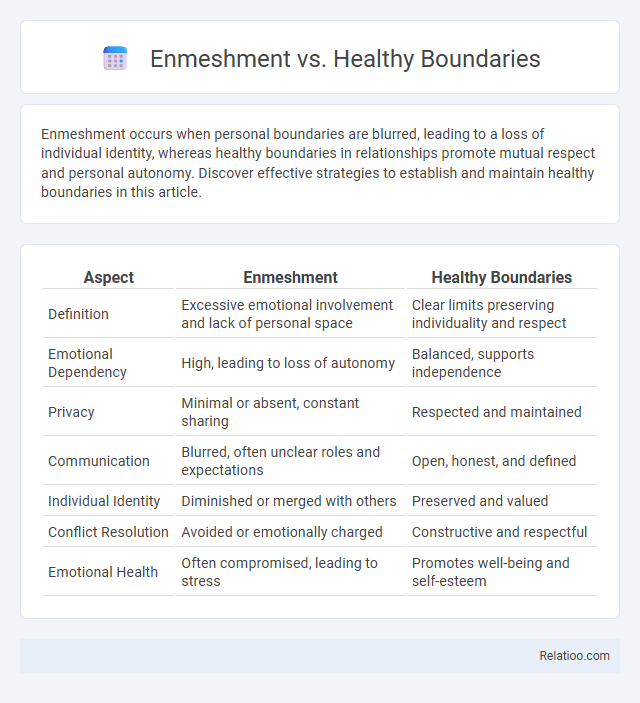Enmeshment occurs when personal boundaries are blurred, leading to a loss of individual identity, whereas healthy boundaries in relationships promote mutual respect and personal autonomy. Discover effective strategies to establish and maintain healthy boundaries in this article.
Table of Comparison
| Aspect | Enmeshment | Healthy Boundaries |
|---|---|---|
| Definition | Excessive emotional involvement and lack of personal space | Clear limits preserving individuality and respect |
| Emotional Dependency | High, leading to loss of autonomy | Balanced, supports independence |
| Privacy | Minimal or absent, constant sharing | Respected and maintained |
| Communication | Blurred, often unclear roles and expectations | Open, honest, and defined |
| Individual Identity | Diminished or merged with others | Preserved and valued |
| Conflict Resolution | Avoided or emotionally charged | Constructive and respectful |
| Emotional Health | Often compromised, leading to stress | Promotes well-being and self-esteem |
Understanding Enmeshment: Definition and Signs
Understanding enmeshment involves recognizing excessive emotional involvement and blurred boundaries between individuals, often leading to a loss of personal autonomy. Signs of enmeshment include an inability to establish clear limits, feeling responsible for others' emotions, and difficulty asserting your own needs. Differentiating enmeshment from healthy boundaries is crucial for maintaining balanced relationships that respect individuality and promote mutual respect.
What Are Healthy Boundaries?
Healthy boundaries are essential for maintaining individuality and emotional well-being in relationships by clearly defining limits that protect your personal space, values, and needs. They facilitate mutual respect and effective communication, preventing enmeshment, which occurs when boundaries are blurred and personal identities become overly intertwined. Establishing healthy boundaries empowers you to balance connection and autonomy, fostering healthier, more resilient relationships.
Key Differences Between Enmeshment and Healthy Boundaries
Enmeshment involves blurred or absent personal boundaries where individuals overly rely on each other emotionally, often leading to loss of autonomy and identity. Healthy boundaries establish clear limits that allow for emotional connection while maintaining individual independence and self-respect. The key difference lies in the balance of closeness and separateness: enmeshment merges identities, whereas healthy boundaries honor distinct personal limits.
Common Causes of Enmeshment in Relationships
Common causes of enmeshment in relationships include unclear personal boundaries, over-dependence on others for emotional support, and a lack of individual autonomy. Enmeshment often stems from family dynamics where roles and identities are overly intertwined, preventing healthy separation and self-expression. Your ability to recognize and establish healthy boundaries is essential to avoid the emotional confusion and loss of identity associated with enmeshment.
Impact of Enmeshment on Mental and Emotional Health
Enmeshment blurs personal boundaries, leading to emotional dependency and difficulty in self-identity, which can severely impact your mental health by increasing anxiety and lowering self-esteem. Healthy boundaries, by contrast, promote emotional autonomy, enabling individuals to maintain a strong sense of self and resilience against stress. Without clear limits, enmeshment fosters codependency and emotional exhaustion, often resulting in chronic stress and impaired emotional regulation.
Benefits of Maintaining Healthy Boundaries
Maintaining healthy boundaries improves emotional well-being by fostering self-respect and reducing stress from over-involvement in others' lives. Clear boundaries enhance interpersonal relationships by promoting mutual respect and preventing enmeshment, where personal identities become blurred. This balance supports individual growth, autonomy, and healthier social interactions.
Recognizing Enmeshment in Family Dynamics
Recognizing enmeshment in family dynamics involves identifying blurred boundaries where personal identities and emotions are excessively intertwined, leading to a lack of individual autonomy. Healthy boundaries promote emotional separation, allowing family members to maintain distinct identities while fostering support and connection. Enmeshment often manifests through over-involvement, control, and difficulty in expressing personal needs without guilt or conflict.
Steps to Set and Strengthen Healthy Boundaries
Establishing healthy boundaries involves recognizing personal limits and clearly communicating them to others to foster mutual respect and emotional well-being. Key steps include identifying your values, assertively expressing your needs without guilt, and consistently reinforcing limits in relationships. Regular self-reflection and seeking feedback help strengthen these boundaries, preventing enmeshment, which occurs when emotional boundaries blur and individuality is compromised.
Overcoming Enmeshment: Practical Strategies
Overcoming enmeshment requires establishing clear, healthy boundaries by recognizing and respecting individual autonomy within relationships. Practical strategies include assertive communication, setting limits on emotional involvement, and fostering independence through self-awareness and personal goals. Consistent boundary-setting helps replace enmeshment patterns with balanced connections, promoting emotional well-being and mutual respect.
Building Resilient Relationships Through Healthy Boundaries
Building resilient relationships requires establishing healthy boundaries that promote individual autonomy while fostering trust and mutual respect. Enmeshment, characterized by blurred emotional boundaries and excessive dependence, undermines personal growth and can lead to codependency. Healthy boundaries create a balanced dynamic where partners support each other's independence, enhancing emotional resilience and long-term relationship stability.

Infographic: Enmeshment vs Healthy Boundaries
 relatioo.com
relatioo.com